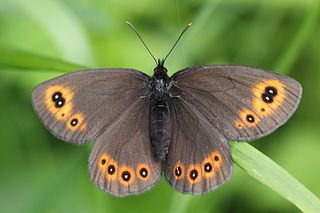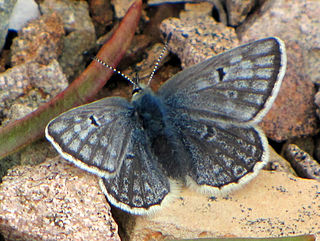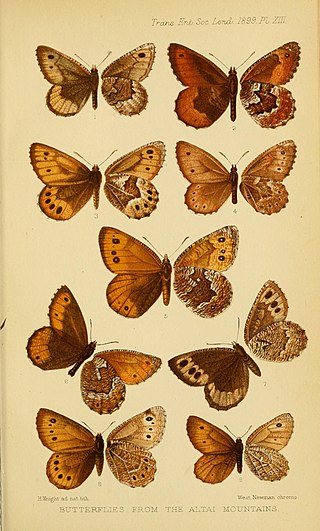
Erebia ligea, the Arran brown, is a member of the subfamily Satyrinae of the family Nymphalidae. This brown is widespread in south-eastern and northern Europe. It prefers mixed woodlands at low altitudes. It is rarely seen in open areas. This species was first described by Carl Linnaeus in his 1758 10th edition of Systema Naturae, and the type locality is Sweden.

Erebia medusa, the woodland ringlet, is a member of the subfamily Satyrinae of the family Nymphalidae.

Oeneis is a butterfly genus of the Satyrinae. All but one of its members are Arctic, sub-Arctic or high-altitude alpine in distribution. Some of the members of the genus are among the butterflies that can get along in the harshest climates of any butterflies. Four species in Europe, more are found in Arctic Russia, Siberia, Mongolia, Arctic North America and the Rocky Mountains. Curiously, there are no observations from Greenland. The development of most species takes two years.

Oeneis chryxus, the chryxus Arctic or brown Arctic, is a butterfly of subfamily Satyrinae found in the far northwest regions of Canada and the United States. The brown Arctic has highly variable colorings, which tend toward light yellow to orange brown wings that help camouflage it against its mountainous rocky habitat. The larvae feed on local grasses and take two years to develop. This longer development period results in flights of adult brown Arctics only once every two years. The butterflies feed on nectar from various plants as their primary food source.

Oeneis jutta, the Jutta Arctic or Baltic grayling, is a species of butterfly in the subfamily Satyrinae with a Circumboreal distribution. It occurs in bogs and tundra in the north of Europe, the Baltic states, the Urals, Siberia, northern Kazakhstan, the Russian Far East, northern Mongolia, northeastern China, North Korea, and northern North America. Larvae feed on Carex and Eriophorum, possibly also Glyceria, Molinia, and Juncus. Ledum palustre is the preferred nectar plant of the adult butterflies. The species has one generation every one or two years, depending on the location.

Colias nastes, the Labrador sulphur, is a butterfly in the family Pieridae. In Europe, it is found in the north of Norway and Sweden and on rare occasions in northern Finland. It is also found in North America, specifically in Alaska, Canada, and the Rocky Mountains, Washington, Montana and on Greenland. In Asia, it is found in the Altai Mountains, the border regions of Russia, China, Mongolia, Kazakhstan, the Sayan Mountains, the north of Siberia, and in the Chukotka Autonomous Okrug.

Colias tyche, the Booth's sulphur or pale Arctic clouded yellow, is a butterfly in the family Pieridae. It is found from Baffin Island west along the Hudson Bay and arctic coasts of the Nunavut and Northwest Territories mainland and the southern tier of Arctic Islands to northern Yukon, Alaska, and Eurasia.

Colias hecla, the northern clouded yellow or hecla sulphur, is a butterfly in the family Pieridae. In Europe, it is found in the northern part of Norway, Sweden and Finland up to heights of 900 m. It is also found in Greenland, Alaska, the Northwest Territories, Yukon, Quebec, Labrador, Manitoba, the Chukot region, eastern Chukotka, and the Russian Far East.

Agriades glandon, the Arctic blue or Glandon blue, is a species of butterfly in the family Lycaenidae. It in found in Eurasia and North America.

Oeneis nevadensis is a species of butterfly in the family Nymphalidae. It is commonly known as the great Arctic, Nevada Arctic, great grayling, Felder's Arctic, or Pacific Arctic. It is native to northwestern North America.

Oeneis melissa, the Melissa Arctic, is a species of butterfly in the family Nymphalidae.

Oeneis magna is a butterfly of the family Nymphalidae. It was described by Ludwig Carl Friedrich Graeser in 1888. It is found from the Altai Mountains to southern Siberia and the Russian Far East, Mongolia, northern China and Korea. The habitat consists of sparse woodlands and mountain tundras.

Oeneis bore, the white-veined Arctic or Arctic grayling, is a butterfly, a species of Satyrinae that occurs in North America and Asia.
Oeneis macounii, the Canada Arctic or Macoun's Arctic, is a butterfly of subfamily Satyrinae that occurs in North America.
Oeneis rosovi, the Philip's Arctic or early Arctic, is a species of butterfly in the subfamily Satyrinae. It occurs in Siberia and the northern parts of North America.
Oeneis polixenes, the Polixenes Arctic or Norique Alpin, is a species of butterfly in the subfamily Satyrinae. It has a Circumpolar distribution occurring in northern parts of North America the Arctic Urals, Kamtchatka, Yakutia, Chukchi Peninsula, and northern Siberia.

Erebia rossii, the Arctic alpine or Ross's alpine, is a member of the subfamily Satyrinae of the family Nymphalidae. It is found in Arctic North America and northern Eurasia.
Erebia pawloskii, the yellow-dotted alpine, is a member of the subfamily Satyrinae of the family Nymphalidae. It is found in North America in northern British Columbia, Yukon, and Alaska. It is also found in the Sayan Mountains, and from northern Mongolia to Yakutia and Kamchatka. The habitat consists of grassy areas in and above wet tundra, as well as bogs.

Erebia discoidalis, the red-disked alpine, is a member of the subfamily Satyrinae of family Nymphalidae. It is found in North America from eastern Quebec, through northern Ontario, and the northern Prairies to northern British Columbia, the Northwest Territories, Yukon, and Alaska. It reaches just into the northern U.S. between Michigan and Montana, and also occurs in Asia, where it has been recorded from the Chukot Peninsula to the eastern Sayan Mountains and Amur. The habitat consists of large, open, grassy bogs and other areas with acidic soils.

Erebia fasciata, the banded alpine, is a member of the subfamily Satyrinae of family Nymphalidae. It is found from central Siberia, through Alaska, Yukon, and mainland Northwest Territories and Nunavut to Hudson Bay. It also occurs on Banks Island and Victoria Island.















